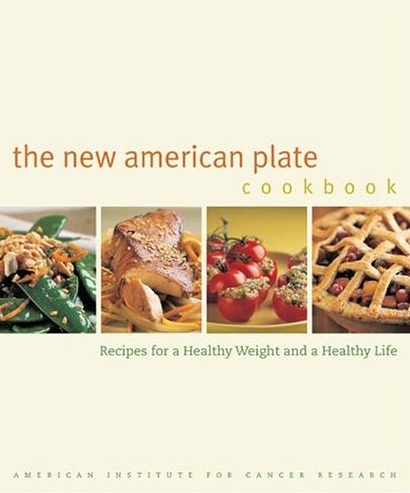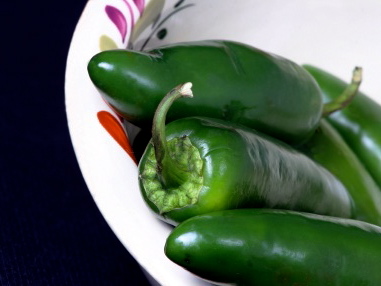
reference-image, l
(article, Lynne Carstarphen)
[%adInjectionSettings noInject=true][%pageBreakSettings nobreak=true] That the American diet needs an overhaul is hardly a radical proposition. Exactly how we should go about it, though, is a more contentious debate. In The New American Plate Cookbook, the American Institute of Cancer Research puts forth both a cookbook and a simple proposition for healthy eating. AICR’s team of cooks, nutritionists, food writers, and scientists hopes to change the typical meat-centric American meal through a slight shift in proportion. The concept? Visualize your dinner plate as a pie chart, then divide it into thirds: two thirds for plant-based foods, one third for meat. The New American Plate Cookbook reads a bit like a slimmed-down Joy of Cooking, with more than 200 recipes ranging from appetizers to dessert. Like most American cooking these days, it incorporates a range of influences — a little Mediterranean seasoning here, an Asian-inspired technique there. Escarole braised with garlic and red pepper follows a recipe for cauliflower, chickpeas, and green peas simmered in light coconut milk with a dash of curry. Beef stew gets a makeover with the addition of vegetables; the traditional carrots and onions are joined here by kale and green. An elegant fettucine with figs and chiles uses whole-wheat pasta and fat-free yogurt in the sauce. And muffins made with green chiles get a fiber boost from cornmeal and whole-wheat flour. Much of The New American Plate Cookbook is a gorgeously styled and photographed attempt to get you to eat your vegetables. If, like me, you already eat your vegetables, the other part of the book's philosophy — that there should be less on your plate — might be more challenging. I've always thought that figuring out what constitutes a serving is one of the trickiest puzzles of healthy eating. (Hint: it's smaller than you think.) In general, Americans aren't adept at determining appropriate serving sizes; the average serving size of pasta (8 ounces), for example, is four times the standard size as set by the USDA (2 ounces). When I first looked at The New American Plate Cookbook, I wasn't concerned with counting calories, and I already knew the basic tenets of a healthy diet. Instead, I was worried about excess in general: too much carbon in the air, too many cars on the road, too many shoes in my closet. How much was enough? Did I even know how much I really needed to be satisfied? I decided to start with my plate, and so, with the aid of The New American Plate Cookbook, undertook an exercise in standard servings. [%image feature-image float=left width=350 credit="Photo: iStockphoto/akaplummer" caption="Give your plate a spicy kick with dishes featuring chiles."] Each recipe in the book comes with nutritional information based on standard USDA serving sizes. I decided to try out a few meals following the guidelines set forth in the book’s introduction. A half-cup serving of spiced braised lamb with apricots and carrots is about half the portion I would have ladled out for myself. But rounded out with some whole-wheat couscous, curried cauliflower, and steamed green beans, as suggested by The New American Plate Cookbook, a half-cup turned out to be enough. The only problem? Making all those things for a single meal took up far more time than I usually devote to making a weeknight dinner. Many of the book's recipes aren't time-consuming in themselves, but when combined to make a balanced meal, the time commitment can be a little daunting. Not to mention dangerous; sweet potato chili with peanuts took a lot longer to cook than I thought it would, and while waiting for it to be done I ate three of the corn muffins (standard serving size: just one) I'd made to go with it. But at least now I know how much is enough, even if I sometimes choose to have more than enough. Much like vegan baking, cookbooks focused on healthier eating typically rely on substitutions and tricks aimed at lowering fat content: margarine in place of butter, canola-oil spray instead of canola oil poured from the bottle. Frankly, I'd rather eat a little less real cheese, for example, than copious quantities of reduced-fat cheese. And using light coconut milk instead of regular coconut milk was enough for me; I didn't need to lighten it any further by combining it with low-fat milk. Given the luscious imagery of The New American Plate Cookbook, I was also disappointed when some of the dishes I tried were less flavorful than the photographs suggested. Fourteen-Vegetable Pork Stew was a bland letdown, especially considering all the chopping that went into assembling the 14 vegetables. Instead of using diced mild green chiles in the corn muffins, I used a can of whole jalapeños and diced them myself, adding enough extra heat to satisfy my palate. Depending on how spicy you like your food, therefore, use a more liberal hand with the book’s suggested amounts of seasonings. [[block(sidebar). h1.Featured recipes]] Substitutions and seasonings aside, The New American Plate Cookbook serves as an excellent primer for those new to healthy cooking, providing helpful introductions to what may be unfamiliar foods and flavor combinations. And for those of us already on friendly terms with Brussels sprouts and parsnips, The New American Plate Cookbook is a great resource for new ideas and inspiring photographs, as well as a gentle reminder of how much food is enough for your plate. p(bio). Lynne Carstarphen is a writer and editor in San Francisco.

reference-image, l

feature-image, l

featurette-image, l

promo-image, l